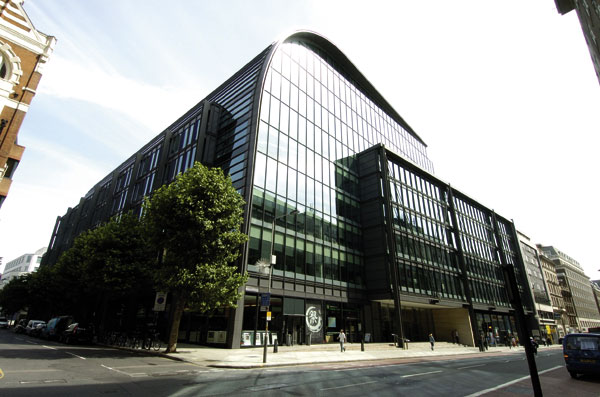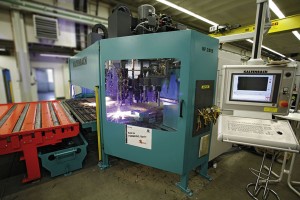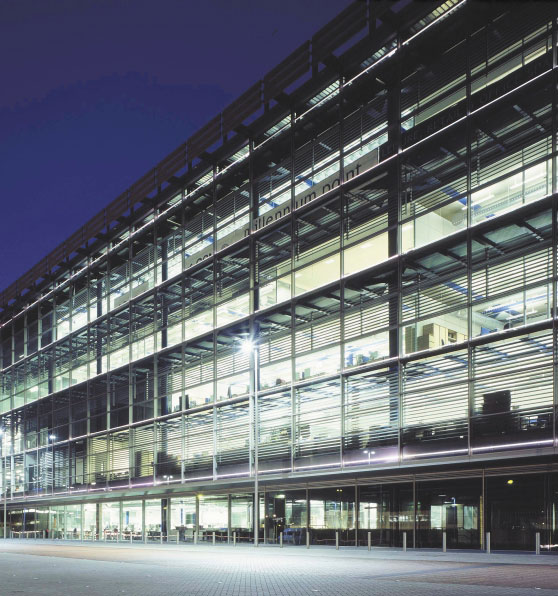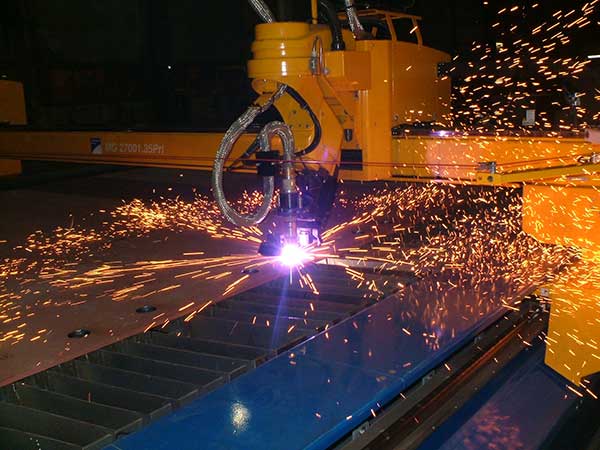Projects and Features
Off-site manufacture boosts sustainability gains
The sustainability benefits of off-site construction have for long been appreciated by designers, contractors and owners of buildings. In the latest in our sustainability series Nick Barrett spells out the advantages and describes some recent projects where the benefits are clearly seen.
The ability to have significant elements of projects executed off-site is a key opportunity for sustainable construction, one that delivers a wide range of benefits from increased safety and quality to predictable construction programmes and reduced waste. Steelwork construction has always delivered these benefits, providing the basis for everything from fully finished modules through light steel framing for housing, strip steel for cladding and roofing to hot rolled sections and plates for the largest buildings and bridges.
Steel construction comes with quality built in. Being fabricated off-site in closely controlled, factory conditions means that everything is produced to high standards of accuracy, defect free – ‘right first time’. Factory based manufacture allows full integration with the latest computer aided design (CAD) and computer controlled production developments. The most efficient designs and manufactured elements based on those designs are ensured. Many processes are fully or at least semi automated and industrial robots are now routinely being used in fabrication shops for operations like welding. Coatings such as intumescent paints can also be applied offsite, Factory application of such coatings reduces the risk of delay to following trades and helps minimise the on-site construction programme.
In summary, the off site manufacture of constructional steelwork means that work can be executed to far higher standards of accuracy than can be achieved with gangs of subcontracted labour on site wet trades, minimising waste to a greater extent than can be achieved by alternative materials.
Safety is promoted by offsite production, as manufacture under factory-controlled conditions is inherently safer than is possible under typical construction site conditions. On-site operations are in the hands of highly qualified site erections teams who are specialists and are obliged to hold recognised qualifications
With on-site work reduced largely to speedy assembly, using constructional steelwork means local communities are spared much of the noise and dust and other nuisance inevitably generated by construction works. Logistical benefits are also derived from steelwork’s ability for timed or just-in-time delivery as dictated by site requirements, which is increasingly important on typically congested regeneration projects, and other inner city sites. In addition, local authorities are particularly pleased when they consider planning applications to hear about the reduced traffic that off site techniques imply.
A key industry objective, lean construction, is also promoted by the use of off-site manufactured constructional steelwork. Lean construction places great emphasis on value for money, supply chain efficiency, quality and the pursuit of continuous improvement. These objectives are all consistent with the governing principles of sustainable construction. The move towards off-site manufacture, with just in time delivery to sites, underpins the drive towards lean construction.
There are significant social benefits associated with off-site construction; it helps promote a permanent and stable factory based workforce, which encourages local community relationships and stronger local economies. Staff retention is greatly improved and factory based workforces can be more easily trained and developed.
Noise reduction
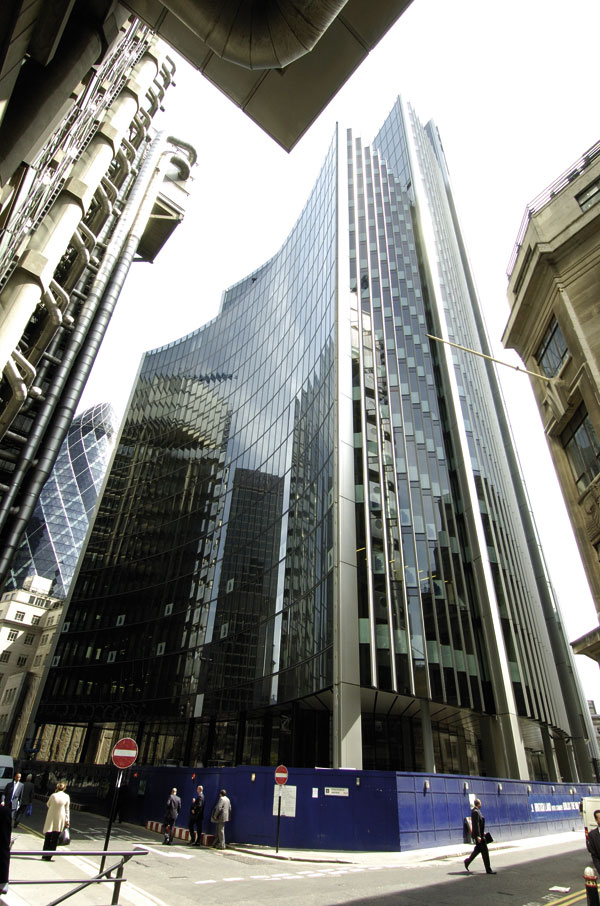
Using prefabricated steel decking on the Willis Building resulted in quieter and faster installation
One of the best ways to stop the nuisance of construction noise from bothering local communities is simply to have the noisy work carried out elsewhere – off-site manufacture obviously means quieter localities. Minimising noise is always a key consideration in areas like the City of London, where financial companies with multi billion pound turnovers carry out sensitive transactions face to face and over the telephone as well as electronically.
The recent Willis Building project, a striking Norman Foster designed City landmark on the old Lloyd’s of London site, benefited not only from having its structural frame fabricated offsite by William Hare, but also from using a prefabricated decking solution. The 65,000 sq m building comprises two structures, one of ten and one of 29 storeys, linked at the ground floor and sharing a two storey basement.
Off-site fabricated decking had been used on other projects but not on the scale of this complex building with its complicated floor plates. Using prefabricated decking, with large sheets designed to fit exactly, meant there was no on site cutting. The result was a quieter, faster decking process.
Richard Lees Steel Decking Managing Director Nick Grimsey said: “We faced the logistical challenge of getting the correct pre-fabricated deck bundles to the right location on site, at the right time. By working closely with our deck manufacturers Corus Construction and Engineering Products, we established an efficient and effective logistical process to overcome this.’
Faster construction programmes
On another high profile London development the Kohn Pedersen Fox & Associates designed office block Mid City Place occupies a prominent island site. The 30,000 sq m development was designed and fast track constructed in just 15 months, showing just how offsite manufacture can contribute to speedy construction programmes.
The building comprises a steel frame and composite floors, with a large proportion of pre assembled and standardised steel components incorporated into the design. 3D computer modelling was extensively employed during both the design and the construction phases, and had a major impact on the project’s success and the speed of its construction.
Large rectangular floor plates provide regular and uninterrupted floor spaces that can accommodate changing use over time, maximising the flexibility that the building can afford to tenants.
Advanced manufacturing technology
Startling advances have been made in the productivity of offsite manufacturing processes in recent years, gains that have been shared with clients of the constructional steelwork sector. Manufacturers of specialist fabricating equipment like Kaltenbach, FICEP, Peddinghaus, Voortman and Rösler have invested successfully in research and development to bring forward new technology that produces continuous advances in productivity, precision and quality.
Saw and drill lines for example have doubled output capability over the past 15 years. Robotic structural fabrication welders are now being introduced to steelwork contractors’ workshops that reduce typical welding process times by up to 80%, removing the last human potential bottleneck in their production process.
Robotic welders can fully integrate into overall CNC, CAD based structural steel fabrication process, with dramatically reduced operator costs per tonne. Special software generates the welding sequences, which can easily be adapted to suit customer specific requirements.
A 400% increase in plate processing speed has recently been claimed by Kaltenbach for a new double headed plasma plate processing centre, which with a 12 tool carousel cuts complex profiles, drills, taps and countersinks holes some 400% faster than its single headed counterpart.
Equipment manufacturers now produce increases of a factor of three in structural drilling speeds by using new solid carbide drill bits, said to be twice as fast as Tungsten Carbide Tipped systems and five times faster than HSS.








